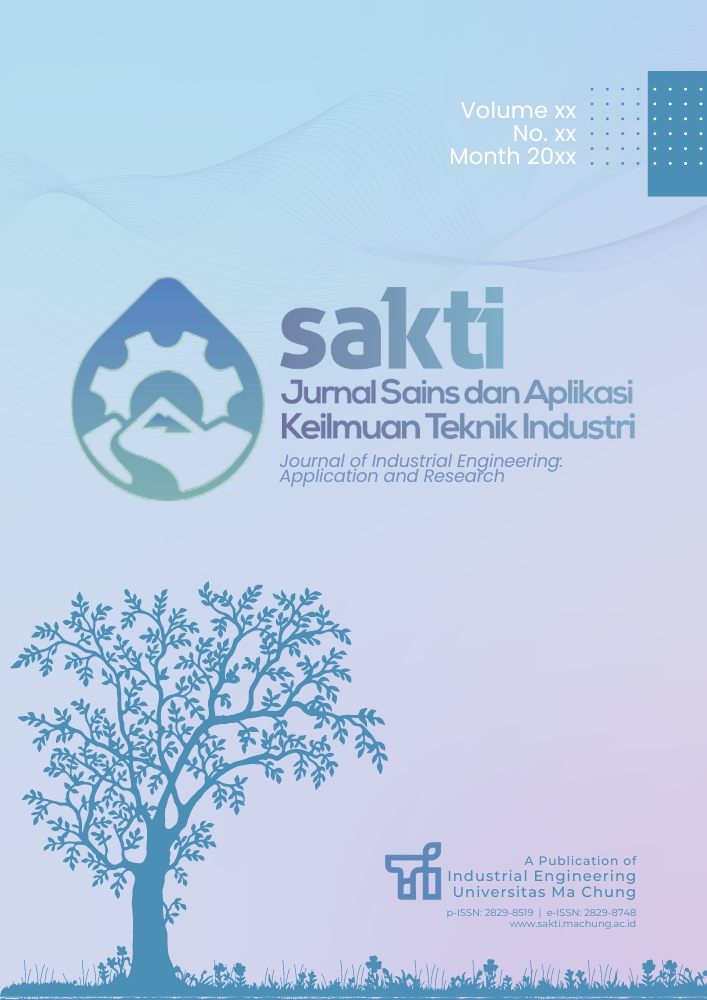Evaluasi Permasalahan Kekuatan Splicing Benang pada Mesin Winding PT INS dengan Metode Seven Tools
DOI:
https://doi.org/10.33479/jtiumc.v3i2.77Keywords:
seven tools, textile, winding machine, yarn manufacturing, yarn splicingAbstract
Yarn manufacturing engineering stands as one of the initial phases in the textile industry and holds considerable significance in determining subsequent process qualities. PT INS specializes in producing ring spun yarn, wherein the final stage integrates an automatic yarn quality control mechanism within the winding machine. When the sensor identifies any yarn irregularity, an automatic cutting process initiates. Additionally, the winding machine incorporates a yarn splicing procedure to reconnect separated yarn ends or join yarn during cop changes. Any flaw in this splicing process can lead to a weak yarn splice, evident in the diminished Retained Spliced Strength (RSS), which in turn impacts subsequent weaving and knitting processes. PT INS encountered a yarn splicing issue, evidenced by consistently low RSS values from each spindle on its winding machines. An analysis was conducted employing various tools, including Control Charts, Fishbone Diagrams, Check Sheets, and Pareto Diagrams, to pinpoint the problematic spindle and identify the root cause of the splicing problem. Subsequently, improvement measures were proposed based on the analysis of each contributing factor. These steps aim not only to enhance the splicing process within the winding machine but also to elevate overall yarn quality. Through this approach, PT INS aims to rectify the splicing discrepancies, ultimately ensuring a more robust splicing process within the winding machine and elevating the overall yarn quality.
References
Antony, J., McDermott, O., & Sony, M. (2023). Revisiting Ishikawa’s Original Seven Basic Tools of Quality Control: A Global Study and Some New Insights. IEEE Transactions on Engineering Management, 70(11), 4005–4020. https://doi.org/10.1109/TEM.2021.3095245
Berlin Jinu, C. K., & Thangamani, K. (2018). Effect of retwisting parameters of splicing on the retained splice strength. Indian Journal of Fibre and Textile Research, 43(4), 499–503.
Cheng, K., & Lam, H. (2000). Physical Properties of Pneumatically Spliced Cotton Ring Spun Yarns. Textile Research Journal, 70(12), 1053–1057.
Das, A., Ishtiaque, S. M., & Parida, J. R. (2005). Effect of fiber friction, yarn twist, and splicing air pressure on yarn splicing performance. Fibers and Polymers, 6(1), 72–78. https://doi.org/10.1007/BF02875576
Gandhi, K. L. (2019). Yarn preparation for weaving: Winding. In Woven Textiles: Principles, Technologies and Applications (2nd ed.). Elsevier Ltd. https://doi.org/10.1016/B978-0-08-102497-3.00002-7
Ginting, R., & Fattah, M. G. (2020). Production quality control with new seven tools for defect minimization on PT. Dirgantara Indonesia. IOP Conference Series: Earth and Environmental Science, 452(1). https://doi.org/10.1088/1755-1315/452/1/012082
Gulhane, S., Shirsath, P., Kolte, P., & Kakde, M. (2019). Improving productivity of winding by optimization of splicing parameter. Journal of the Textile Association, 80(1), 5–7.
Hossan, M., Rahman, M., Islam, T., Alam, M. A., & Mahmud, T. (2021). Evaluation & Analysis of Splice strength of Ring Spun Yarn Produced from Different Types of Cotton Fibers. October.
Khairunnisa, H., Bintang, H. S., & Safitri, S. N. (2023). Process Improvement of Winding Machines for Reducing Cone Defects: Case Study in Yarn Manufacturing Company. Proceeding of The 2nd International Conference on Engineering and Management in Industrial System (ICOEMIS), 411–422.
Lam, H., & Cheng, K. (1998). Properties of pneumatic spliced short-staple ring spun yarns. Research Journal of Textile and Apparel, 2(1), 21–35.
Muratec. (2011). Muratec 21C Process Coner Manual Book. Murata Machinery.
Permono, L., Salmia, L. A., & Septiari, R. (2022). Penerapan Metode Seven Tools Dan New Seven Tools Untuk Pengendalian Kualitas Produk (Studi Kasus Pabrik Gula Kebon Agung Malang). Jurnal Valtech, 5(1), 58–65.
Putra, A. M., & Prakoso, I. (2021). Pengendalian Kualitas Produk Bubble Window dengan Metode New Seven Tools (Studi Kasus: PT. X) Bubble Window Product Quality Control with New Seven Tools Method (Case Study: PT X). Jurnal Rekayasa Sistem & Industri, 8, 97–103. https://doi.org/10.25124/jrsi.v8i02.473
Putri, N. T. (2022). Manajemen Kualitas Produk dan Jasa. Andalas University Press.
Sjarifudin, D., & Kurnia, H. (2022). The PDCA Approach with Seven Quality Tools for Quality Improvement Men’s Formal Jackets in Indonesia Garment Industry. Jurnal Sistem Teknik Industri, 24(2), 159–176. https://doi.org/10.32734/jsti.v24i2.7711
Somadi, S., Priambodo, B. S., & Okarini, P. R. (2020). Evaluasi Kerusakan Barang dalam Proses Pengiriman dengan Menggunakan Metode Seven Tools. Jurnal INTECH Teknik Industri Universitas Serang Raya, 6(1), 1–11. https://doi.org/10.30656/intech.v6i1.2008
Ünal, P. G., Arikan, C., Özdil, N., & Taşkin, C. (2010). The Effect of Fiber Properties on the Characteristics of Spliced Yarns: Part II: Prediction of Retained Spliced Diameter. Textile Research Journal, 80(17), 1751–1758. https://doi.org/10.1177/0040517510363189
Uyanık, S. (2019). A research on determining optimum splicing method in terms of fiber types and yarn count. Tekstil ve Konfeksiyon, 29(1), 22–33. https://doi.org/10.32710/tekstilvekonfeksiyon.451476
Downloads
Published
How to Cite
Issue
Section
License
Copyright (c) 2023 Jurnal Sains dan Aplikasi Keilmuan Teknik Industri (SAKTI)

This work is licensed under a Creative Commons Attribution-NonCommercial-ShareAlike 4.0 International License.









